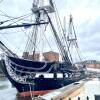Advisory: This story includes descriptions of abuse and oppression of Black and Indigenous people, which were the norm in colonial-era Boston.
The steeple of North Church is where two lanterns were raised — “one if by land, two if by sea” — to launch Paul Revere’s famous ride that began the American Revolution.
But the church has discovered that steeple was built with donations from church members who made their money from enslaved laborers.
Logwood was a rare and coveted tree that grew in what is now Belize, and it was valuable as a source of pigments for dyes. As the church’s own website explains: “In 1727, a group of men engaged in the lucrative trade, known as the Gentlemen of Honduras Bay, donated several loads of logwood to Old North. The Baymen, however, were not the ones doing the logging. They relied on enslaved Black people, and likely a number of enslaved Indigenous people, for every step of the process of logwood cutting: scouting for logwood locations, felling the trees, removing the bark, cutting it into shorter lengths, transporting it via river to the coast, and literally hauling it from location to location.”
The church sold that logwood to raise money for its steeple.
The church also recently closed a colonial-reenactment chocolate shop that had operated in its basement named for Captain Jackson, a colonial-era seaman and merchant, when researchers discovered that Jackson had brought slaves to Suriname and traded them for cacao beans.
The church has developed new teaching materials and guides to engage the public in conversation about its historic ties to enslavement.
This story is part of the project Enslavement History of the Freedom Trail, a collaborative effort between GBH News and Boston University students to detail the mostly hidden history behind some of Boston's most well-known sites.








